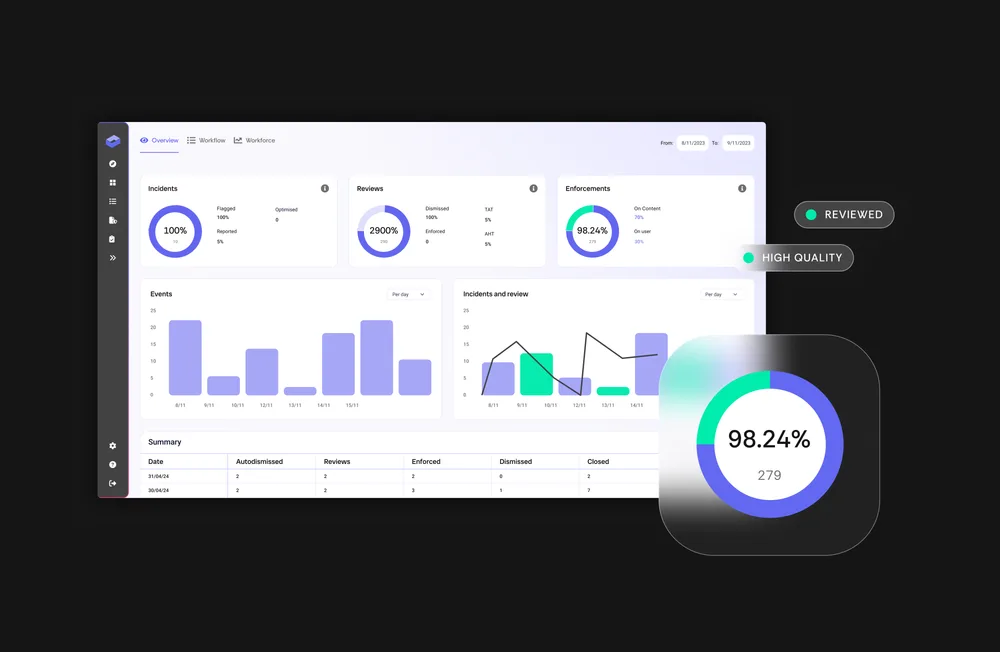
The AI Content Moderation Platform for Trust & Safety
Your trust and safety co-pilot. Powered by best in class models and automation to deliver content moderation at scale.
Content moderation,
reimagined.
From detection to compliance, Checkstep's AI content moderation platform streamlines the moderation of digital content.
Online platforms face growing challenges in detecting harmful and unwanted content. From hate speech and child safety, to cultural nuances and evolving regulatory requirements. Manual review at scale is slow, costly, and inconsistent, while automated approaches often lack the ability to balance safety with freedom of speech.
Checkstep was built to solve this. Our AI content moderation platform acts as your trust and safety co-pilot, combining cutting-edge AI and automation with human oversight. Detect content of interest faster, set and enforce policies, and stay ahead of compliance obligations. All while empowering your teams to make informed, accurate decisions.
Benefits
Built to scale with you
Flexible. Automated. Transparent.
Everything you need to moderate with confidence.
Flexible and customisable
Every platform is unique. Checkstep lets you choose the right models and workflows to match your policies and priorities.
Efficient and automated
Reduce reliance on human moderators with AI-powered automation that scales content detection without sacrificing accuracy.
Transparent and trusted
From real-time confidence scores to DSA transparency reporting, Checkstep gives you full control and visibility of content.
Features
- Policy & Compliance Management
- Content Scanning & Detection
- Content Moderation & Automation
- Moderation & Transparency Reporting
Set the standards for safe online spaces with policies you control and enforcement you can trust
Supports all major policy types
Tap into multiple best-in-class AI models to scan all content formats with speed and accuracy
The perfect blend of models
Find the optimal balance of automation and human moderation for greater moderation efficiency
Automate DSA compliance with instant reports and seamless EU database updates
Scalability
AI models can scale to your needs, including coverage in 100+ languages, for timely moderation – even as content volume grows.
Consistency
Moderating with AI ensures consistent application of moderation policies for every review, reducing the risk of human error.
Speed
With sub-50 millisecond latency, AI processes and reviews content in real-time – faster than human moderators.
Cost
Automation reduces the demand on human moderators, lowering operational costs and increasing efficiency.
Expertise
Combine trust and safety expertise with established partnerships with leading gaming service providers, including Modsquad.
Availability
AI operates continuously, providing 24/7, round-the-clock monitoring and moderation without breaks or downtime.
How Checkstep helped 123 Multimedia double its subscription rate
Checkstep’s AI content moderation platform helped 123 Multimedia transition to 90% automated moderation, leading to a 2.3x increase in subscriptions and 10,000x faster validation of new profiles.

“Checkstep's expertise in Trust and Safety is second to none. Their understanding of our needs for day 1 has helped us streamline our operational efficiency.”
CEO, 123 Multimedia


FAQs
Get answers to our most frequently asked questions
Learn more about our AI content moderation platform
-
What is the EU Digital Services Act (DSA)?
The EU Digital Services Act (DSA) is a European Union regulation that came into force in 2024.
-
Who does the DSA apply to?
The DSA applies to almost all digital services that operate in or provide services to users in the European Union.
-
Where is my data stored? How do I know my content is safe?
Yes, Checkstep supports large volumes in terms of throughput and individual case size. Depending on content requirements, customers can pick and choose the AI providers to best cover their large volumes at acceptable costs.
-
What is a Very Large Online Platform (VLOP) under the DSA?
A Very Large Online Platform (VLOP) is defined in the DSA as an online service with more than 45 million average monthly active users in the EU — roughly 10% of the EU population.
-
Can you scan large volumes of data?
Yes, Checkstep integrations require a small amount of engineering work to send Checkstep content via an API and to process the response from your AI scanning and policy. Customers can submit content without a technical integration but most systems require some integration to support end to end moderation.
-
What are the penalties for non-compliance with the DSA?
What are the penalties for non-compliance with the DSA?
-
What is the UK Online Safety Act (OSA)?
The UK Online Safety Act (OSA), passed in 2023, is the United Kingdom’s flagship online safety law.
-
How does the OSA differ from the DSA?
While both the DSA (EU) and OSA (UK) address online safety, their focus and enforcement differ.
-
What languages do you cover?
We currently process 100 languages natively and we can support every language through translation.
-
Do you offer age verification?
Yes, we offer Age Verification services. We can apply age estimation algorithms and also integrate end-to-end age and/or identity verification flows.
-
Do you cover live streaming?
Yes, we have live streaming capabilities.
-
How can Checkstep help us remain DSA compliant?
We can help with preparing for the DSA and OSB implementation, whilst remaining consistent with data protection legislation. We can work directly with your governance team if required to run gap analysis and formulate a risk profile comfortable to your individual business. We will then help drive the implementation of the strategies through Checkstep tooling, your current current stack integrations and overall trust and safety operation to streamline legislative requirements and drive down compliance costs.
-
Do you support flexible workflows?
Yes, we fully support a mix of:
- Different queues can be set-up based on different detection policies, regions, regulations;
- Escalations within the platform to ensure content can get seen quickly by the right team;
- Different queues can be manned by different teams of moderators;
- Queues can be ranked according to needs: i.e. first-in-first-out, minimising SLAs, optimising for severe harms etc.
Want to see our AI content moderation platform for yourself?
Book a demo to see how it can help you deliver safer, more inclusive content at scale.











